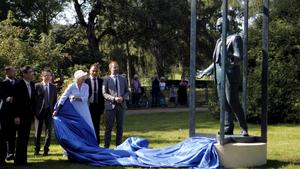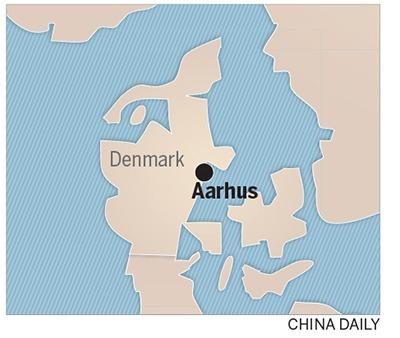 A 3-meter bronze statue of Bernhard Arp Sindberg is unveiled by Danish Queen Margrethe II on Saturday in Aarhus, Denmark, to honor his heroism in helping save the lives of tens of thousands of Chinese civilians during the Nanjing Massacre of 1937-38. (LIN JING / XINHUA)
A 3-meter bronze statue of Bernhard Arp Sindberg is unveiled by Danish Queen Margrethe II on Saturday in Aarhus, Denmark, to honor his heroism in helping save the lives of tens of thousands of Chinese civilians during the Nanjing Massacre of 1937-38. (LIN JING / XINHUA)
Bernhard Arp Sindberg might be little known in his home country of Denmark, but in China, the Aarhus native is revered for his humanitarian efforts in saving the lives of tens of thousands of Chinese civilians during the Nanjing Massacre of 1937-38.
In a gesture to commemorate his heroism, a 3-meter bronze statue of Sindberg was unveiled by Danish Queen Margrethe II on Saturday in Marselisbourg Memorial Park, Aarhus, Denmark.
The memorial resulted from a Chinese-Danish collaboration involving three artists: Shang Rong, Fu Licheng and Lene Desmentik. It is a gift to Aarhus from the city of Nanjing, which wanted to honor Sindberg, who has been called the Danish Schindler and who is known as "Shining Buddha" and "the greatest Dane" in China.
During the horrific Nanjing Massacre, an estimated 300,000 Chinese people were tortured, maimed, raped and murdered by occupying Japanese troops in the six weeks starting on Dec 13, 1937. Sindberg, who was 26 at the time, succeeded in saving thousands of people by protecting them in a Danish cement factory in the city, where he worked as a guard.
Speaking at the statue unveiling ceremony, Jacob Bundsgaard, mayor of Aarhus, praised Sindberg as "a man of extraordinary character" after history placed him in the midst of one of the most terrible massacres the world has seen.
"We do not know the reason why Bernhard Arp Sindberg reacted at the time as he did, and gave protection to the thousands who, during the massacre, sought refuge at the cement factory where he was a guard," he said. "Maybe, even he never knew the reason himself, but simply reacted because it was once again what he had to do, solely for the reason that it was the right thing."

Peng Zhengang, director of the information office of Nanjing's city government, said: "During the 72 years of his adventurous life, Sindberg had 106 days closely interwoven with the people of Nanjing by witnessing the darkest moment in the history of human civilization - the Nanjing Massacre. In the face of catastrophe and death, Sindberg ... did not retreat or escape, he set up and took care of a refugee camp in Kiangnan Cement Works," increasing the chances of survival for thousands of Chinese.
He said Sindberg recorded everything he had witnessed, leaving behind "irrefutable evidence for us to remember that part of history and giving the best interpretation of fraternity and courage to reach out to the people in need and assist the people in distress at risk of his own life".
Sindberg, together with Karl Guenther, a German engineer who also worked at the cement factory, decided to open the factory gates to Nanjing people. After a few days, thousands had taken refuge there.
To ward off Japanese bombs, Sindberg painted a huge Danish flag on the roof of the cement factory and raised both the Danish flag and two German swastika flags - two nations the Japanese respected and were not at war with. The flags helped deter Japanese troops from entering.
Sindberg and Guenther set up a makeshift hospital for the Chinese refugees, and repeatedly risked their lives driving into the occupied city to collect food, medicine and supplies from the Red Cross.
It is estimated that Sindberg saved tens of thousands of people during the massacre, which has been called "the forgotten Holocaust". He is still revered in China for his efforts.
The Danish rose breeder Rosa Eskelund named a yellow rose after the Aarhus native, calling it "Nanjing Forever - the Sindberg Rose". It grows at the Bernhard Sindberg memorial outside the Nanjing Memorial Hall, a place that honors the memory of Sindberg and the Chinese people he saved from the massacre.
Sindberg later emigrated to the United States and settled in California, where he lived until his death in 1983.
wangmingjie@mail.chinadailyuk.com


